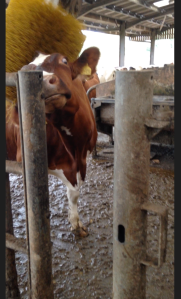Heya friends,
I finished my dairy placement last week and had a tiring but amazing time, so I thought I should tell you all about it. As I said in my previous post, it was at Bore Place dairy farm, which is part of a group called commonwork which teaches kids about gardening and nature and helps disabled and disadvantaged people to learn and develop skills, as well as holding lots of family open days filled with outdoor activities. Despite this, the farm was very much a working one, and was not really there for teaching people – it was an organic milk business.
I turned up on my first day at 7:45, having caught the 6:38 train and still half-asleep, and was greeted by Martin, the very friendly and talkative herdsperson, who was just finishing the morning milking. I was handed a “scraper” (a broom handle with a massive squeegee on the end) and was told to scrape all of the muck from the milking parlour out onto the concrete area outside, where a big mechanical scraper dragged it down to a drain which lead to a cesspit. I then had to scrape the massive cow shed free of muck, and by the time this was finished I was exhausted. Every morning this was my job and, weirdly, by the end I really enjoyed it – it was very therapeutic!
In the afternoons I helped with milking, which involved herding the cows from the field to the cow shed using a mule (a kind of farm-buggy) and then ushering them through to the parlour. Then, we had to dip the udders in iodine foam to get rid of any bacteria on them, wipe them and attach the clusters. The clusters were pulled of automatically when the machine thought that there was no more milk and then we dipped the udders in iodine liquid, which protected them, as they do not close for 20 minutes after milking. Killing the bacteria on the udders was very important because it prevented mastitis, which is a real problem with dairy cows.
Between the milkings, I would accompany one of the herdspersons to feed cows up in the fields, help with various farm tasks like spreading bedding or sealing the silage pit, and trim the cows’ feet. The latter was particularly interesting because I learnt how important healthy feet are in cows. If they go lame, their milk yield goes down, they are less likely to go into calve, and overall they cost the farmer a lot of money. That’s why the cows’ feet are trimmed yearly. Sometimes, pebbles burrow through the claw and hit the soft tissue underneath, causing infection and puss or blood to fill underneath the claw. This liquid creates uncomfortable pressure on the soft tissue and so you have to cut down to the abscess to drain it. Then, it is sprayed with antiseptic and a cow slip is placed on the other claw to raise it and take all pressure off the painful one.
Unfortunately, I was too early for calving, although one had been born early so here’s a cute picture: 
In the cow shed there were these massive yellow brushes that rotated that the cows used to scratch themselves with. (Also very cute).
I came out the week absolutely shattered, but I learnt so much and can’t wait to (hopefully!) return after my first year at uni!
I’ve just completed a week at a small animal vet practice, so will be writing up on that soon (we’ll see how much I procrastinate…)
Until then, byeeee!
Sophie x